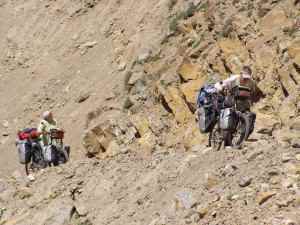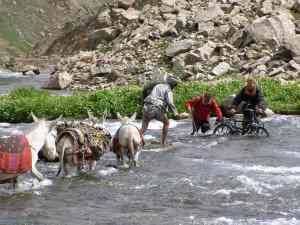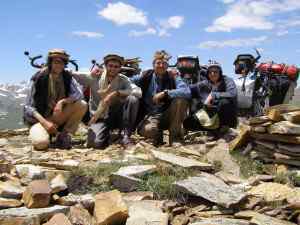
update reports pictures
report 28 report 34 report 35
home
velotour 2004-2006
contact

update
reports
pictures
report 28
report 34
report 35
Slower than a human fingernail grows, the continents move on the liquid layer of the earth, but the effect can be catastrophic. About 50 Million years ago the Indian subcontinent collided with the Eurasian continent, and in the course of a million of years developed the gigantic Himalaya Mountains, which are still growing up. The pressure build up is released suddenly in violent shock waves. Many people here in Pakistan believe these earthquakes demonstrate the destructive power of the Islamic God Allah, and that he is punishing the people in this area for being bad Moslems. The biggest earthquake in the history of Pakistan happened in October of 2005 with a power of 7 on the Richter scale and more than 50.000 people died.
We are not the kind of people who enjoy catastrophes or the misery of other people, but our way to China headed through this destroyed area. Life is really not easy for the people here. In the town of Balakot almost all the buildings were destroyed. Part of the asphalt road has been completely torn away. Deep clefts in the surface show the power of the shockwaves. Absolutely all the people now live in tents or primitive cabins made out of corrugated iron, because the area around Balakot was declared a "red zone" in which rebuilding is strictly forbidden, as more earthquakes are possible.

|
Despite the awful destruction we met a lot of rich Pakistani people who were here for vacations, for you can still reach the tourist location Naran by car. The beautiful landscape here in the north of Pakistan often reminded us of the green mountain-valleys of Switzerland, and we asked ourselves, why we had to move so far from home, to see scenery like this. North of Naran the road became worse and worse. Accompanied by two young cyclists, Emanuel and Yoan from France, we wanted to cross the 4100m high Babusar-pass, and then cycle 3000m downhill to the the famous Karakorum Highway. According to the map the route over the Babusar Pass is just a little road, and it is written in the travel guides that the road is passable by a 4 wheel drive vehicles from the middle of July. But not this year as the people were too busy with the aftermath of the earthquake to clear the approach road. So we had to go with our heavily loaded bicycles over parts of the road still blocked by big stones or take to slippery fields of snow. Mostly we had to push the bicycles a task which often needed two people and took a couple of days.

|
Prepared for the worst we asked local people about the condition of the road to Babusar Pass. They shook their heads and made swimming like motions with their arms. Some kilometres further on the bridge, which had crossed a rapid river, had been torn away. Crossing was impossible, so deep and rapid was the stream. Further downstream the river was less dangerous and we saw how local people fought their way through the floods. So now we had two possibilities. Retreat 200 difficult kilometres to the Karakorum Highway or fight our way across the river. Without hesitation we choose the latter. Five hours later our bicycles and luggage were safe on the other side. It needed two people, often waist deep, to move each bicycle, centimetre by centimetre, across the strong current. Taking stock after the crossing we realised that a camera, a wrist-computer and several shoes had been damaged by the water. But we were very happy that nothing worse had happened. We still had everything that really mattered.

|
But the adventure Babusar Pass was not the end, for it got much worse. We were in Kohistan, a province famous all over Pakistan, because the radical, conservative, Moslems of the area were hostile to foreigners. Shortly before the pass the road was so steep that we had to push the bicycles, accompanied by a lot of children. In the beginning they were very helpful and assisted by pushing the bicycles, but then they started to dismantle our things and open our cycle-bags. Finally they demanded money, erected barricades on the road and began to throw stones. In the beginning we could drive them away, but they came again and again. A young boy, approximately 14 years old, was extremely violent. The stones he threw became bigger and bigger and he took aim directly to our heads. Lina put her helmet on to protect her head. When it had became too dangerous, we ran up the hill and tried to catch the malefactor. But we had no chance. At 4000m we simply had not the power or the agility to match kids who live in the high mountains. But finally, and fortunately, we eventually drove them away and were able to recuperate. Only then did I realize that my head was bleeding as a result of being hit by a large stone and that blood was dropping on my trousers and shirt. I had put some toilet paper under my cap to soak up the blood. Exhausted and bleeding we reached the 4100m pass, and could see the 8125m high mountain Nanga-Parbat in the distance.

|
In retrospect we would prefer not to have suffered this kind of adventure. andreaslina@yahoo.de